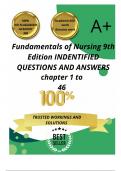Fundamentals of Nursing 9th Edition by
Taylor, Lynn, Bartlett Test Bank | Chapter
1-46 |Complete Guide A+
,Table of Contents
1
Chapter 01: Introduction to Nursing 2
Chapter 02: Theory, Research, and Evidence-Based Practice 11
Chapter 03: Health, Wellness, and Health Disparities Chapter 20
04: Health of the Individual, Family, and Community Chapter 29
05: Cultural Diversity 37
Chapter 06: Values, Ethics, and Advocacy Chapter 45
07: Legal Dimensions of Nursing Practice Chapter 54
08: Communication 62
Chapter 09: Teaching and Counseling 69
Chapter 10: Leading, Managing, and Delegating 77
Chapter 11: The Health Care Delivery System 86
Chapter 12: Collaborative Practice and Care Coordination Across Settings 93
Chapter 13: Blended Competencies, Clinical Reasoning, and Processes of Person-
Centered Care 100
Chapter 14: Assessing 109
Chapter 15: Diagnosing 117
Chapter 16: Outcome Identification and Planning 125
Chapter 17: Implementing 135
Chapter 18: Evaluating 142
Chapter 19: Documenting and Reporting 150
Chapter 20: Nursing Informatics 158
Chapter 21: Developmental Concepts Chapter 164
22: Conception Through Young Adult Chapter 173
23: The Aging Adult 182
Chapter 24: Asepsis and Infection Control 190
Chapter 25: Vital Signs 200
Chapter 26: Health Assessment 211
Chapter 27: Safety, Security, and Emergency Preparedness 220
Chapter 28: Complementary and Integrative Health 230
Chapter 29: Medications 239
Chapter 30: Perioperative Nursing 250
Chapter 31: Hygiene 260
Chapter 32: Skin Integrity and Wound Care 269
Chapter 33: Activity 279
Chapter 34: Rest and Sleep 289
Chapter 35: Comfort and Pain Management 298
Chapter 36: Nutrition 307
Chapter 37: Urinary Elimination 316
Chapter 38: Bowel Elimination 326
Chapter 39: Oxygenation and Perfusion 336
Chapter 40: Fluid, Electrolyte, and Acid-Base Balance 346
Chapter 41: Self-Concept 356
Chapter 42: Stress and Adaptation 365
Chapter 43: Loss, Grief, and Dying 375
Chapter 44: Sensory Functioning 384
Chapter 45: Sexuality 393
Chapter 46: Spirituality 403
, 3
)
Chapter 01: Introduction to Nursing
1. Which of the following statements accurately describe an element of nursing? Select all that
apply.
A) The skills involved in nursing are primarily technical in nature.
B) The primary focus of nursing is to assist individuals to recover from illness.
C) The science of nursing is the knowledge base for the care that is given.
D) The art of nursing is the collection of knowledge through research.
E) Nursing is considered to be both an art and a science.
F) Nursing is a profession that used specialized knowledge and skills.
2. Which of the following set of terms best describes nursing at the end of the Middle Ages?
A) continuity, caring, critical thinking
B) purpose, direction, leadership
C) assessment, interventions, outcomes
D) advocacy, research, education
3. Which of the following is a characteristic of nursing practiced from early civilization
to the 16th century?
A) Most early civilizations believed that illness had supernatural causes.
B) The physician was the priest who treated disease with prayer.
C) The nurse was a nun committed to caring for the needy and homeless.
D) Nursing changed from a spiritual focus to an emphasis on knowledge expansion.
4. In what time period did nursing care as we now know it begin?
A) pre-civilization
, 4
)
B) early civilization to 16th century




